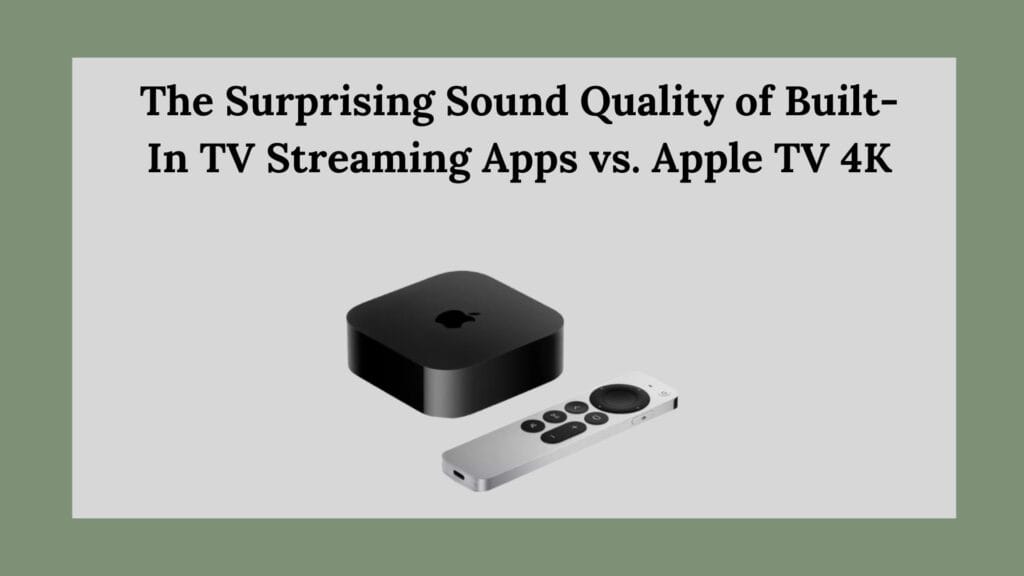In the ever-evolving world of home entertainment, the debate between using built-in streaming apps on smart TVs versus dedicated streaming devices like the Apple TV 4K has been a hot topic among enthusiasts. Many consumers invest in high-quality streaming devices, believing they will provide the best overall experience. However, recent experiences have led some to question this assumption, particularly regarding sound quality. This blog explores the intriguing notion that built-in streaming apps on certain TVs may outperform dedicated devices like the Apple TV 4K in terms of audio performance.

The Context: A Shift in Perception
For years, I was a staunch advocate of the Apple TV 4K. Its sleek design, user-friendly interface, and seamless integration with other Apple products made it a staple in my home entertainment setup. The picture quality was consistently impressive, and the device offered an extensive library of apps and features that catered to my viewing habits. However, my perspective shifted dramatically after I began using the built-in streaming apps on my LG C4 OLED TV.
A New Experience with Built-In Apps
As I started to explore the native apps on my LG TV—such as Netflix, Disney+, and Prime Video—I noticed something unexpected: the sound quality was noticeably better than when using the Apple TV 4K. This revelation prompted me to conduct a more in-depth comparison between the two options.
Sound Quality Comparison
One of the most striking differences I encountered was in dialogue clarity. When watching a movie or series, it became apparent that the built-in apps produced audio that was not only louder but also clearer. For instance, during a tense scene in Challengers on Prime Video, background announcements and subtle sound effects were more discernible when using the LG app compared to streaming through the Apple TV. This observation raised questions about why this disparity existed. One possible explanation could be related to how each platform processes audio. The LG TV’s built-in apps are optimized for its specific hardware, potentially allowing for better sound calibration and output than what is achieved through an external device like the Apple TV.
Bass Response and Overall Audio Experience
Another notable aspect of the sound quality was the bass response. The LG’s native apps seemed to deliver deeper and more resonant bass tones than those experienced through the Apple TV 4K. This difference became particularly evident during action sequences or musical performances where low-frequency sounds play a crucial role in creating an immersive experience. While many users might rely on external sound systems or soundbars to enhance their audio experience, it’s essential to recognize that not everyone has access to high-end audio equipment. For those who primarily use their TV’s built-in speakers, having superior sound quality from native apps can significantly enhance their viewing experience without requiring additional investment.
Picture Quality: The Apple TV 4K Advantage
Despite the advantages I found with sound quality from built-in apps, it’s important to acknowledge that the Apple TV 4K still holds its ground when it comes to picture quality. In my comparisons, I consistently found that the Apple device produced brighter images with better color contrast and HDR support compared to what I experienced with LG’s native apps.
The Importance of Picture Quality
Picture quality is undeniably a critical component of any home viewing experience. The Apple TV 4K excels in delivering high dynamic range (HDR) content that enhances color vibrancy and detail in dark scenes—a feature that many viewers prioritize when selecting a streaming device. However, this leads to an interesting dilemma: while one may enjoy superior picture quality from a dedicated device like the Apple TV 4K, if the sound quality does not match up, it can detract from overall enjoyment. This balance between audio and visual elements is crucial for an immersive viewing experience.
User Preferences: Sound vs. Picture Quality
Ultimately, personal preferences will dictate which option is best for individual viewers. Some users may prioritize picture quality above all else, making devices like the Apple TV 4K their go-to choice. Others might find that clear dialogue and robust sound enhance their enjoyment of movies and shows more significantly than visual fidelity.
Considerations for Choosing Between Options
When deciding between built-in streaming apps and dedicated devices like the Apple TV 4K, consider these factors:
- Audio Setup: If you have an advanced audio system or soundbar connected to your setup, you might find that both options deliver satisfactory sound quality.
- Viewing Habits: If you primarily watch dialogue-heavy content such as dramas or talk shows, you may benefit from exploring built-in apps for improved clarity.
- Content Type: For action-packed films or immersive experiences where sound design plays a crucial role, testing both options can help determine which delivers better results for your preferences.
- Budget: If you’re looking to save money or simplify your setup, relying on built-in streaming apps may be a practical choice without sacrificing too much quality.
Conclusion: Rethinking Your Setup
The revelation that built-in streaming apps can sometimes outperform dedicated devices like the Apple TV 4K in terms of sound quality challenges long-held assumptions about home entertainment setups. While picture quality remains a significant factor for many viewers, it’s essential not to overlook audio performance—especially if you primarily rely on your TV’s speakers. As technology continues to advance, manufacturers are optimizing their products for enhanced performance across various aspects of home entertainment. For consumers, this means more choices than ever before when it comes to selecting their preferred viewing method. Whether you choose to stick with your trusted Apple TV 4K or explore the capabilities of your smart TV’s built-in apps, it’s worth experimenting with both options to discover what works best for your unique preferences and setup. After all, enjoying your favorite movies and shows should be about creating an experience tailored specifically to you—one where both sight and sound harmoniously come together.
